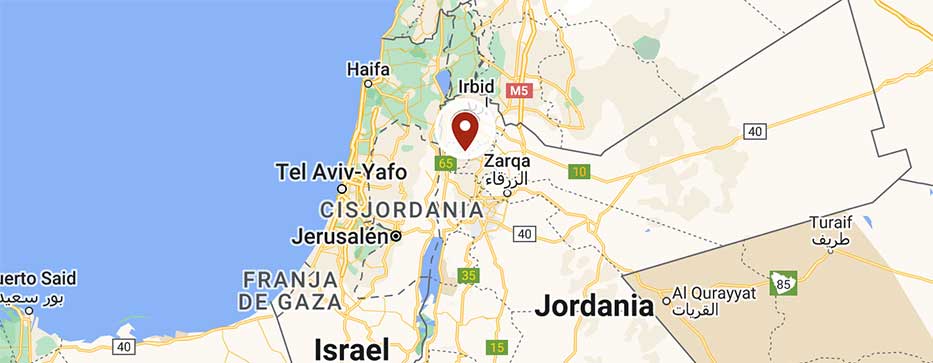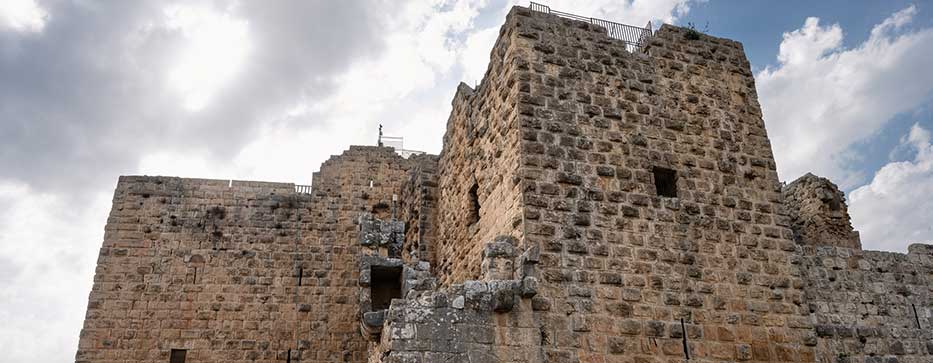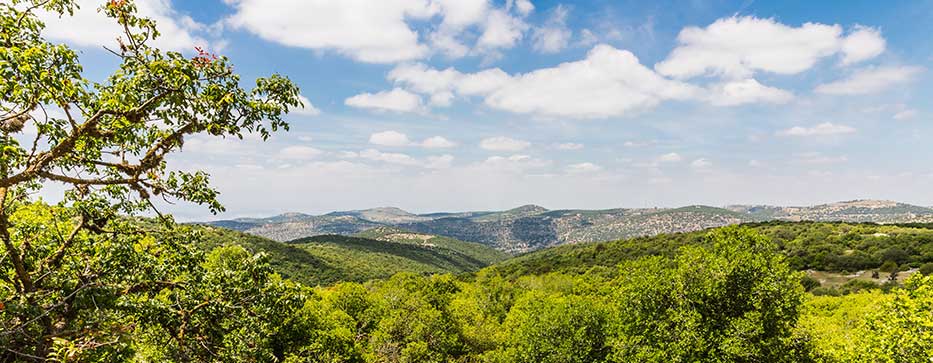Ajloun, also often written as Ajloun, is a small town in northern Jordan where many of our circuits reach, since it offers some relevant attractions for travelers, both from a historical and environmental point of view. On this page we explain where exactly it is and what to see in Ajloun, as well as other practical information such as how to get there.
Ajloun It is located in the extreme north of Jordan, very close to Irbid (about 35 km) and not far from the capital, Amman (about 70 km). It belongs to the governorate of Ajloun. It is also not far from the two borders of the area: with respect to Israel, the King Hussein border post is about 70 km by road, while the Syrian border is about 45 km by road.
From an environmental point of view, the highlight of Ajloun is that it is located in the heart of the Jordan Mediterranean climate, with not too warm summers and relatively mild winters, with rainfall levels higher than those of other Jordanian regions.
Its hilly environment offers a green color that contrasts with the rest of the country, and here there are many trees that can also be seen in many other territories of southern Europe, such as strawberry trees or pistachios. That is why this landscape is protected as a nature reserve and is one of the most recommended places for travelers who love nature.

It’s unclear when Ajloun emerges as a population and some historians associate it with the Moab king Eglón, who is mentioned in the Bible and from whom his name would derive. In any case, what seems certain is that Ajloun existed already in the twelfth century, period in which its famous castle was built, since there are remains of a Byzantine church, which indicates that it would have been built sometime in the V-VII centuries.
That fortress is the one that, in the end, gave strategic and military importance to this enclave, which was occupied successively by Ayyubids, Mamluks and Ottomans. The latter are the ones that left a more evident importance in the town, as evidenced by its mosque, expanded in the sixteenth century by that empire that had the dominion of Ajloun ever since.
From that moment on, minimizing external military threats, Ajloun has always developed an agricultural role, as shown by historical documents, in which an important production of wine, fruits and vegetables is certified.

The main monument to see in Ajloun is undoubtedly his castle, also known as Qala’at Ar Rabad). It is located about 3 kilometers west of the city, so you will have to solve the issue of displacement, as we tell you below.
It is interesting to delve into a really relevant period of Jordanian history: the offensives and counteroffensives of Crusaders and Ayyubids in the twelfth century. In fact, the castle of Ajloun It was built between 1184 and 1193 by a general (and nephew) of Saladin, Izzidin Usama, with the aim of containing the campaigns of the Christian military who aspired to recover the holy places for their religion. This mountain, the Awf (at an altitude of about 1,250 meters above sea level), occupies a strategic position to monitor the environment, specifically the wadis that lead to the Jordan Valley and that could be used by the Crusaders as entry routes to here from their settlements on the Sea of Galilee.
Ajloun Castle It came to have seven towers and a security moat of more than a dozen meters. Although it was enlarged at the beginning of the thirteenth century, it was taken and damaged by other invading enemies, in this case the Mongols, in the middle of that century. The Mamluks, successors of the Ayyubids, regained their control. In later centuries, Ottoman troops were quartered here, although in the end it came under local management. Several earthquakes in the nineteenth and twentieth centuries severely affected the structure, but the state of conservation today has improved a lot thanks to constant restorations.
Today, when all these episodes are only distant and almost mythical stories, what remains for the tourist are extraordinary views of the surroundings, which convey a feeling contrary to the original: of peace.
For those who also want to take a walk around the small town of Ajloun, the most outstanding monument is its Great Mosque, built by Ayyubids and Mamluks, although its current appearance is mainly due to the Ottoman expansion of the sixteenth century. This can be seen, above all, in its spectacular minaret, of strong Turkish style.
On the outskirts of Ajloun, about 5 km from the center, is another place that may be interesting for travelers more interested in Christianity: Anjara. According to tradition, the Holy Family would have taken refuge here, specifically in a cave, on their return to Galilee, after learning that the king of Israel Archelaus was still with the intention of ending the life of Jesus. At present, the sanctuary of the Virgen de la Montaña is a small temple erected in honor of that event, inside which a commemorative cave is recreated.

If you want to spend more time with Ajloun To discover other places in addition to the castle, there is one activity that stands out above all: hiking. Around the town extends the Forest Reserve of Ajloun, one of the most interesting in the country for its biodiversity and its contrast with respect to other Jordanian natural spaces: it is a Mediterranean habitat, with its corresponding flora and fauna.
Walking here, the traveler can discover oaks, pistachios, strawberry trees, carob trees and other trees typical of the countries of southern Europe, for example. And with a little luck, you’ll be able to spot skunks, martens, or even wild boars. Wolves and jackals also inhabit here, although they are much more elusive.
This natural orchard is maintained in good condition thanks to the Royal Society for the Conservation of Nature, which opted to protect this area of about 1,300 hectares for its environmental value. They have also been in charge of developing a network of trails to discover the main corners of the reserve, among which are:
Of course, there are more routes mapped out and signposted. Some of them are guided and with lunch included, upon payment of the corresponding entrance. In addition, a branch of the Jordan Trail passes through this area, specifically the section that goes from Ajloun to Fuheis, with a distance of approximately 60 km.
Ajloun It is very close to Jerash and Amman, so it is most common to include the visit of this place as part of an excursion through northern Jordan. The easiest thing is to get here by road and with a private vehicle, either a taxi or a bus with its own driver. These are the approximate distances and durations, including other places further away from the country:
Public transportation options are limited. The JETT company offers a tourist service from Amman that also passes through Jerash, usually with two weekly departures. Another option is the minibuses with departures from Amman, Irbid and Jerash, but it is a slow and unpredictable solution, since these vehicles only leave when they are full.
On the other hand, if you want to get to Ajloun Castle, you must access with some means of transport, as it is located about 3 kilometers from the center, a distance that is also uphill. There are taxis that offer this service from the city, although you can also get there by car to the same ticket office.






Fill out the form below to receive a free non-binding quote tailor-made by a specialized agency in Jordan.
DMC travel agency specializing in tailor-made trips to Jordan
Mandala Tours, S.L, NIF: B51037471
License: C.I.AN-187782-3
Hello!
Contact one of our travel advisors for commercial assistance.
